2011 iowa hoops
Yesterday, I highlighted one of the main issues with Michigan's offense in recent games: their struggles with the hard hedge against the pick and roll. When the Wolverines—especially Trey Burke—run a high screen, opponents have found success by having the man guarding the screener provide a strong double-team on the ballhandler, limiting his ability to drive to the basket and making passes into the post difficult.
There are several ways to counter the hard hedge, as discussed yesterday in both the post and the comments (thanks to all of you who added your thoughts—I'm not a basketball coach, so any additional knowledge about the game is very valuable). One such counter, brought up yesterday by MGoUser Kilgore Trout, is to get the opponent to commit to the hedge and then immediately cross back over, which should create an opening for a pass to the near-side corner.
Though he didn't execute it perfectly, and the play didn't result in a basket, Tim Hardaway Jr. provides a decent example of how to do this, and you'll be able to see the possibilities it opens. With teams over-committing to the screen, something inevitably must open up, and in this case several holes emerge in the defense. Here's the setup, as Hardaway has just received a pass from Trey Burke:
As you can see, Hardaway has the ball on the left wing, and Jordan Morgan is setting an off-ball screen for Douglass in the middle of the court—Stu will head to the near-side corner and Burke will clear out to the high side on the opposite side of the court so the team maintains proper spacing. Now that the team is properly spread out, Hardaway calls for a screen, and Morgan makes his way over:
Hardaway starts to dribble towards Morgan, but as soon as Melsahn Basabe (#1, guarding Morgan) jumps out to hedge, Hardaway makes a quick crossover dribble back to the near side—this is exactly how you want to counter Basabe's aggressiveness in this instance, especially with Hardaway's man already attempting to fight over the pick:
This opens up several possibilities. If Morgan was ready for the crossover, he could crash hard to the basket, forcing the defender guarding Douglass to slide down and vacate the corner or give up an open dunk (or the defender guarding Novak could do this—either way, a open corner three should be there). Morgan doesn't roll hard, likely because he hadn't fully set the screen when Hardaway made his move, and also because Hardaway will drive to the lane himself. Hardaway's drive accomplishes what Morgan's roll would do—force the near-side defender to commit, leaving Douglass alone in the corner:
Unfortunately, what you see above is where this particular play doesn't work as well as it should. Hardaway picks up his dribble before he gets into the lane, so when he passes to Douglass, the sliding defender still has time to get back out and force Stu to drive. I think if Hardaway takes another dribble, it would create enough separation for Douglass to get an open three, a much-preferable option in Michigan's offense (and especially with Stu, who's much more comfortable as a stand-still shooter than a slasher). As it is, the defender is able to get out on Douglass, and Stu drives and misses a pull-up jumper in the paint. Full video of the play:
As was pointed out yesterday, the biggest problem here isn't the play, but the execution. If Morgan dives hard to the basket, or Hardaway penetrates further into the paint, this play likely results in a bucket. Instead, Douglass is forced to settle for a contested fallaway in the lane when he doesn't have the space to get off an open three. If Michigan can execute this adjustment with a little more precision, however, it should help keep opponents from over-committing to the hedge defensively and allow the Wolverines to run the pick-and-roll more effectively.
Coming on the heels of Wednesday's ugly overtime win over Northwestern, Michigan's lethargic effort against Iowa on Saturday resulted in a 75-59 loss. Many of the team's problems offensively can be traced to the ineffectiveness of the pick and roll. John Beilein has placed a lot of emphasis on the pick and roll this season, and it is often how Michigan starts out their offensive sets. Earlier this year Trey Burke ran it with great effect, and his offense flourished; getting freed up to start out plays allowed Burke to utilize his quickness and finishing ability to create baskets for himself and others.
While Burke has managed to score 19 points in each of the last two games, his efficiency has plummeted, as he's just 12-30 (40%) from the field during that span, a number that's actually inflated due to several garbage-time buckets against the Hawkeyes. I believe the main issue lies with the pick and roll, and how teams are now defending it.
Both Northwestern and Iowa hedged hard with the man defending the screener, putting extra pressure on Burke, keeping him from turning the corner and driving, and making it difficult for the diminutive guard to find passing lanes. Let's take a look at an example to see what's bogging down the offense. Here's a play from Saturday where Iowa stymies two pick-and-roll attempts, eventually forcing a turnover.
First, the setup. Burke has the ball on the left side early in the shot clock, and Jordan Morgan gets into position to set a screen towards the middle of the court:
Burke dribbles over to the pick, and Morgan dives to the basket. The problem is that Morgan's defender, Melsahn Basabe, comes out to double Burke instead of rolling to the post with Morgan. This is just after the mesh point of the pick, and already Burke is being forced to retreat:
Even though Morgan is open and has a lane to the basket, Burke doesn't have a path to get him the ball. By the time Basabe peels off and heads back to Morgan, Burke is all the way out on the center-court logo, still trying to turn the corner and in no position to make a play. He's forced to pass off to Novak, and the offense will reset.
Novak will swing it down to Smotrycz, then the ball will come back around to Burke, where he calls another play, again asking for Morgan to come over and set a screen. Again, Iowa hedges, and Burke doesn't help matters at all by running nowhere close to the pick, giving his man ample room to go over the top and stay right with him:
Basabe hounds Burke as Devyn Marble (#4) also chases him to the sideline—there's no chance Burke can pass to Morgan on the roll, and once more he's forced to pass off to Novak. Iowa turns up the pressure at the end of the shot clock, and Novak will lose control of the ball, leading to an Iowa steal right before the shot clock expires.
Here's the full play on video:
At no point in this play did Michigan even have a decent look at the basket, and it was due to their inability to counter the hard hedge, an issue that would present itself several times over the course of the game. So, what do we learn from this, and how can Michigan counteract this level of pressure?
Burke and Morgan have to execute better. Teams can defend the pick and roll however they want and you're going to run into problems if you don't do a fundamentally sound job of setting it up. On the first screen in the above play, Morgan rolls to the basket early—he never comes into contact with Marble, nor does he affect the path Marble must take to stay on Burke, eliminating the potential for a switch or even a delay in getting out to Burke. On the second screen, Burke doesn't come close to the pick, and Marble can just run right over the top of Morgan while staying between Burke and the basket. Morgan has to stay at home and make sure he sets a solid screen, and Burke has to do a better job of rubbing against the screen to give it maximum effect. Neither happened in conjunction on this play.
Michigan needs to adjust how they run the P&R. Interestingly, Michigan appears to have a built-in adjustment for the hard hedge, and it was highlighted by former Wolverine point guard David Merritt over at UMHoops back in December. Watch what happens against Memphis when Burke runs a high side screen with Jon Horford; the Tigers hedge, so Horford sets himself again and sets a pick coming back in the other direction, getting Burke one-on-one and giving him space to get into the lane:
There's another option I've seen put forth (possibly by Brian, and also by some frustrated Tweeters this weekend), and that is to run the high screen not with Burke, but with Tim Hardaway, Jr., whose extra size would help him see and pass over the double-team. I'm skeptical about how well this would work, as Hardaway isn't nearly as quick as Burke—he's more effective offensively when coming off screens away from the ball and getting passes while cutting. It is an option, however, and could also be a way to get Hardaway going towards the basket instead of settling for long jumpers.
Run the pick-and-pop with Smotrycz. Morgan is an effective finisher around the basket, but he's not a threat to pop out to the three-point line and knock down a jumper, which allows defenders to abandon him at the perimeter and wait for help to arrive while hedging on Burke. This isn't the case with Smotrycz, who is still connecting on nearly 46% of his three-point attempts this season despite a recent shooting slump. Having Smotrycz set the screen and then slide out for an open three would likely give Burke a better passing lane if the opponent comes with a hard hedge, and if Smotrycz can knock down those open looks, opponents would be more reticent to double Burke.
Run more plays with off-ball screens. There's also this: Michigan has a lot of great plays that aren't predicated on an early on-ball screen. It's possible teams have found how to take advantage of Burke's greatest weakness—his size—and can render him ineffective on most pick and roll plays. I would think Beilein can devise a way to counter the hard hedge—we've seen one such adjustment above—but if he can't, there's a lot more to the Wolverine offense. Michigan had a lot of success against Wisconsin by setting off-ball screens in the corner for Zack Novak, but I didn't see much of that against Iowa. When facing off against teams with bigger guards and athletic big men, like Iowa, Michigan might have to look for a similar way to generate offense.
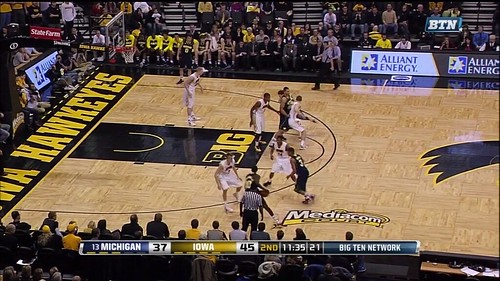
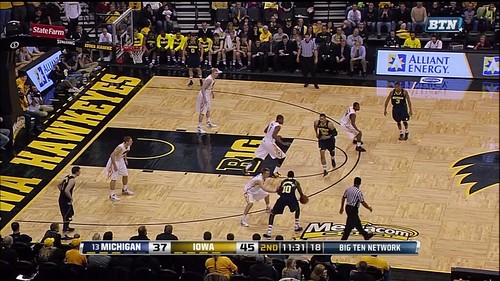
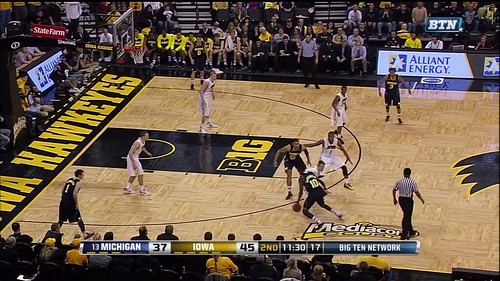
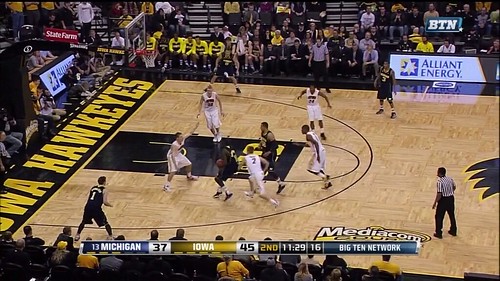

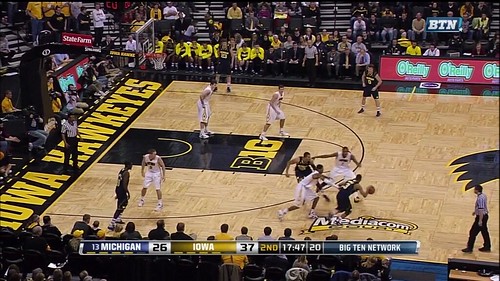

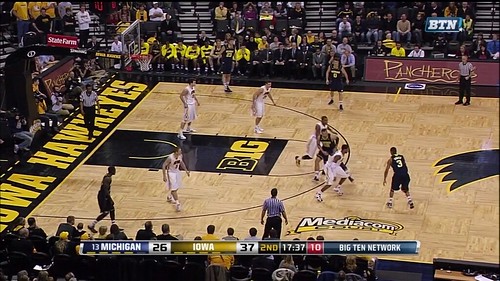
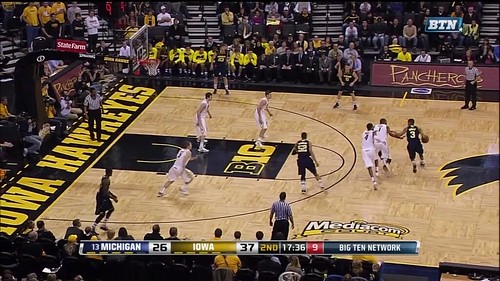
6